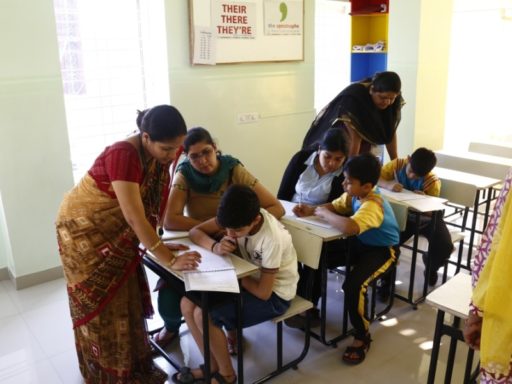
Continuing from Part 1 and Part 2
Let’s talk a little more about the different components that the students will be dealing within the e-school.
What is the general path that the students will follow for each core period?
#1 : Subject wise classrooms
– Depending on what subject they are working on, the students will join the classroom for that subject.
– This is where they will receive instructions in different formats (audio, video, photo, documents etc.) and where they will post their assignments and receive feedback from the teachers.
– This is also where they can interact with the teacher for that subject and the rest of the students in their standard.
– Each core subject will have a separate classroom and there will be 1 additional classroom for activities and time pass. So, a Std. 9 student who has 5 core subjects will be a part of 5 + 1 = 6 classrooms.
#2 : Audio instructions
– There are audio instructions from the teacher which is an overview of what is to be done for that session.
Parents can think of this like the “start” of a period. What are we going to do in this session? How are we going to do it? What are the materials that parents have? What do parents have to do… etc. The teacher tells the student all this.
#3 : Actual teaching
– There is a video which has the whole “classroom lecture” experience for that session.
– Students will watch this carefully to understand the concepts expected in that period.
#4 : Blackboard notes
– There is a version of the presentation of the learning without the teachers’ commentary.
– This can be used for quick reference while doing assignments so that the student doesn’t have to keep going through the video lecture.
#5 : Additional assisting audio
– There is additional assisting audio to help with the learning for some sessions, where teachers have felt that it is necessary.
– The additional audios are mainly in English but some parts are repeated in Marathi (and at times, in Hindi). The purpose is to make sure the students “understand” concepts in whatever way possible.
#6 : Worksheet, which comes in the physical form
– Good news! Paper worksheets are printed. We will be sorting them and sending messages for staggered collection times shortly to ensure social distancing
– The homework and classwork expectations from that worksheet are shared too.
#7 : CW, HW question list
– Teachers will discuss and allot the CW for the day through their audio instructions- Students will receive HW assignments on Google Classroom, that they have to solve and submit through the same portal for teachers’ feedback.
– Normally in school, the students have a core period for 35 min and they are expected to do some homework as well. Now, since the students will be doing everything at home, they can just do the classwork and homework continuously in one go.
– They can take short breaks between sessions and keep going.
– More on the suggested schedule and the mindset and discipline that parents will have to enforce in later emails.
Interaction in the classroom (offline part)
– The submission of CW and HW will be done online in that subject’s classroom. The teacher will check the work and post the feedback in the student’s personal folder in the classroom.
– In the classroom the students can also ask doubts and take part in discussions.
– All this interaction is going to be offline. So students can plan (according to their convenience) when they want to do their work. They just have to make sure that the deadline is followed. This will help parents plan when the devices will need to be used!
#8 : Walmiki quiz
– There is a multiple choice question quiz at the end of each lesson which helps the teacher understand the level of understanding. This is through Walmiki.
And in the next emails we will talk about the mindset needed to make the e-school work from home and the way we can keep the students motivated and on-track to minimize academic loss. We will also share some of the challenges that the teacher faces with different kinds of students in the classroom so that if it happens at home, parents are not caught by surprise. We will also be talking about what the online interaction is and what a sample schedule would look like.


